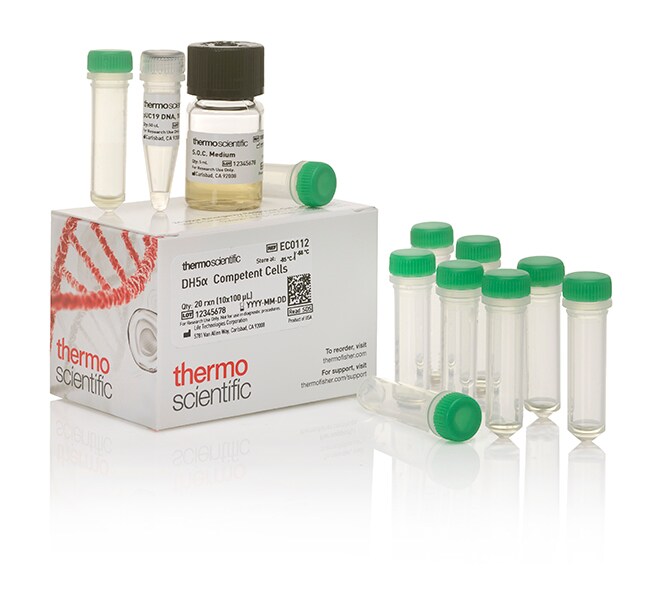Search Thermo Fisher Scientific

Thermo Scientific™
DH5α kompetente Zellen
Thermo Scientific DH5α kompetente Zellen sind hochgradig effiziente, chemisch kompetente E. coli-Zellen, die sich ideal für das Aufbauen von GenbankenWeitere Informationen
| Katalognummer | Menge |
|---|---|
| EC0112 | 10 x 100 μl |
Katalognummer EC0112
Preis (EUR)
137,00
Special offer
Online exclusive
Endet: 21-Jul-2025
149,00Ersparnis 12,00 (8%)
Each
-
Menge:
10 x 100 μl
Preis (EUR)
137,00
Special offer
Online exclusive
Endet: 21-Jul-2025
149,00Ersparnis 12,00 (8%)
Each
Thermo Scientific DH5α kompetente Zellen sind hochgradig effiziente, chemisch kompetente E. coli-Zellen, die sich ideal für das Aufbauen von Genbanken oder Erzeugen von cDNA-Bibliotheken unter Verwendung von aus Plasmid gewonnenen Vektoren eignen. Der φ80dlacZΔM15 Marker bietet α-Komplementierung des β-Galactosidase-Gens aus pUC oder ähnlichen Vektoren, um ein Blau-Weiß-Kolonie-Screening auf bakteriellen Agarplatten zu ermöglichen, die Bluo-Gal oder X-Gal enthalten. RecA1- und endA1-Mutationen in DH5α-Zellen verbessern die Einfügestabilität und Qualität der extrahierten Plasmid-DNA.
• Hohe Transformationseffizienz: > 1 x 109 KbE/µg pUC19 DNA
• Geeignet für routinemäßige Klonierungsanwendungen und solche mit hohem Durchsatz
• Genetische Marker, die Blau-Weiß-Kolonie-Screening ermöglichen
• Praktische zwei Reaktionen pro Röhrchenpackung
• S.O.C. Wachstumsmedium im Lieferumfang enthalten
Anwendungen
DH5α kompetente Zellen eignen sich für eine Vielzahl von Einsatzfällen, die eine hohe Transformationseffizienz erfordern:
• Effizientes DNA-Klonieren aus PCR, cDNA-Generierungsreaktionen
• recA1-Marker erleichtert die Arbeit mit schwer transformierbarer DNA
• Ideal für die Erzeugung von cDNA-Bibliotheken mit aus Plasmid abgeleiteten Vektoren
• Ortsspezifische Mutagenese
Genotyp
F– φ80lacZΔ M15 Δ (lacZYA-argF) U169 recA1 endA1 hsdR17 (rK– mK+) phoA supE44 λ- thi–1 gyrA96 relA1
• Hohe Transformationseffizienz: > 1 x 109 KbE/µg pUC19 DNA
• Geeignet für routinemäßige Klonierungsanwendungen und solche mit hohem Durchsatz
• Genetische Marker, die Blau-Weiß-Kolonie-Screening ermöglichen
• Praktische zwei Reaktionen pro Röhrchenpackung
• S.O.C. Wachstumsmedium im Lieferumfang enthalten
Anwendungen
DH5α kompetente Zellen eignen sich für eine Vielzahl von Einsatzfällen, die eine hohe Transformationseffizienz erfordern:
• Effizientes DNA-Klonieren aus PCR, cDNA-Generierungsreaktionen
• recA1-Marker erleichtert die Arbeit mit schwer transformierbarer DNA
• Ideal für die Erzeugung von cDNA-Bibliotheken mit aus Plasmid abgeleiteten Vektoren
• Ortsspezifische Mutagenese
Genotyp
F– φ80lacZΔ M15 Δ (lacZYA-argF) U169 recA1 endA1 hsdR17 (rK– mK+) phoA supE44 λ- thi–1 gyrA96 relA1
Nur für Forschungszwecke. Nicht zur Verwendung bei diagnostischen Verfahren.
Specifications
ProdukttypKompetente Zelle
Enthält F'-EpisomF'-Episom fehlt
EffizienzHocheffizient (> 1 x 10^9 KbE/µg pUC19 DNA)
ZelltypChemically Competent
BibliothekencDNA
Klonierung methylierter DNANein
Bakterien- oder HefenstammDH5α
Blau-Weiß-ScreeningJa
Hochdurchsatz-KompatibilitätNicht für Anwendungen mit hohem Durchsatz
Propagation von ccdB-VektorenNicht zur ccdB-Vektor-Propagation
VersandbedingungTrockeneis
SpeziesE. coli
FormatRöhrchen
ProduktlinieThermo Scientific™
Zur Verwendung mit (Anwendung)Klonierung
Menge10 x 100 μl
Unit SizeEach
Inhalt und Lagerung
• 10 x DH5α kompetente Zellen (100 µl)
• pUC19 DNA (50 µL) (10 pg/µl)
• S.O.C. Medium (5 ml)
Bei -80 °C lagern
• pUC19 DNA (50 µL) (10 pg/µl)
• S.O.C. Medium (5 ml)
Bei -80 °C lagern
Have questions about this product? Ask our AI assisted search.
This is an AI-powered search and may not always get things right. You can help us make it better with a thumbs up or down on individual answers or by selecting the “Give feedback" button. Your search history and customer login information may be retained by Thermo Fisher and processed in accordance with our
Privacy Notice.